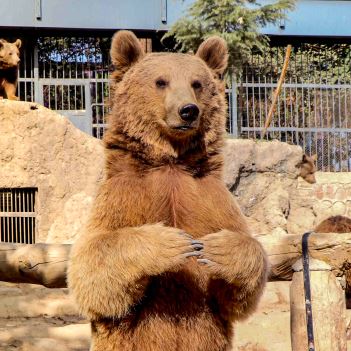ABOUT
Brown bears are brown,They come in all sizes and shades, from a light cream color to almost black. It was once thought that there were 86 different kinds of grizzlies and brown bears in North America alone. Today, scientists agree that there is only one species of brown bear with a lot of variations (or subspecies). Brown bears in interior North America are known as grizzly bears because their brown fur is tipped with white or tan; the word "grizzly” means "sprinkled or streaked with gray." There are several brown bear subspecies found in Europe, Asia, and the Middle East, but they are smaller than their North American relatives and their numbers are currently so low that their populations are at critical risk. All bears have short, thick limbs, a big, heavily built body, and a large head. Look carefully and you’ll notice that most bears walk pigeon-toed, with their feet turned inward. It makes them look a little clumsy when they’re walking, but don’t be fooled—bears can move much more quickly than most people realize. Adult brown bears are not quite as comfortable in trees as their panda, black, sun, and sloth bear relatives, although brown bear cubs are encouraged to climb for safety.
Brown bears have a large hump of muscle on top of their shoulders, and grizzly bears have the most distinctive hump of all. Their great front claws make all brown bears powerful diggers. They may build a shallow bed on the ground made of leaf litter. When the weather cools, they seek out large, cozy dens for their winter home. A den can be a rock cave, a tree hollow, a pile of brush, or a den made by digging into a hillside or under tree roots. Brown bears can spend four to six months a year curled up deep in sleep, in a den. That's one-third to one-half of their lifetime! This sleep is commonly called hibernation, but unlike true hibernation, the bears' body temperature does not drop drastically. However, the bears' heart rate slows from 70 beats per minute to only 10 beats per minute, their metabolism slows, and they do not urinate or defecate all winter!
This "winter sleep" allows the bears to stay alive for a long period of time when there is little or no food available to them. Bears in warmer climates spend less of their time curled up in their dens than those in areas with a longer winter. In fact, the brown bears at the Eram Tehran Zoo stay active year round!
Bears are the only mammals that do not pee or poop for the entire time they are in their winter sleep! In fact, by studying the way bears recycle urine, doctors have been able to help human patients with kidney failure.
HABITAT AND DIET
Brown bears are more versatile in their choice of habitats than any other bear. They may be found in forests, mountain areas, tundra, and even semi-desert areas. Their current range includes Europe, parts of Asia, Japan, and western Canada as well as the united state.This is the largest range of any bear, yet brown bears once roamed a much larger portion of the US, as well as northern Mexico and northern Africa. Currently, the largest brown bear populations are in Russia, Alaska, and Canada.
Brown bears are true omnivores and eat anything nutritious that they find. Most of their diet consists of plant matter, but they certainly eat meat if they can find it. Bears dig for roots, tubers, and insects, scavenge for carrion, and even occasionally hunt prey such as rodents, young deer, and elk. However, the food that first comes to mind when one thinks of bears is salmon. Brown bears live solitary lives once they leave their mother. When bears eat fruit, their scat disperses seeds, which helps keep habitats growing. And when they dig for food like tubers, plant bulbs, and rodents, they stir up the soil, which releases nitrogen into the ground and keeps the habitat healthy. In the spring, brown bears may even eat young calves of bison, elk, and other wildlife, which helps keep those populations in check.
FAMILY LIFE
As brown bear breeding season approaches (May to July), the boars become more aggressive toward each other. To show dominance, they stand upright, growling and roaring at each other. Wrestling matches are common, and either or both boars can be injured by sharp canine teeth. To show submission, a bear may keep its head lowered and back away. Sows with cubs try to steer clear of these fights. Brown bear moms perform an amazing feat while sleeping through the winter: they give birth! After breeding, the sows’ eggs don’t immediately implant in the uterus and continue to grow. Instead, they remain in a state of suspended growth for a period of time, and cubs are not born until January or February, during the coldest part of the winter. The delayed implantation lengthens the pregnancy but also helps ensure that the mother has enough fat stored for her and the developing cubs. There are usually two cubs in a litter, and they are born almost hairless, toothless, and with their eyes sealed shut. They find their mother's nipples by heading for the warmth. Although the sow sleeps through the winter, the cubs spend their time nursing, wrestling, and keeping warm in her fur. The cubs' eyes open when they are six weeks old, and by the time spring comes around they have grown teeth and thick fur and are able to follow the mother outside the den. Depending upon the subspecies of bear, youngsters stay with their mother from two to six years. The mother does not have more cubs until her current offspring are on their own.

